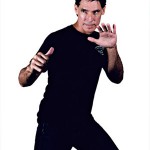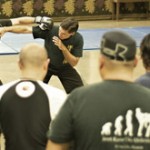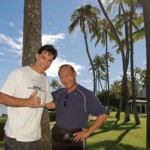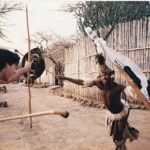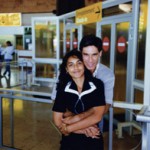Burton-Bruce Connection
Burton Richardson gave up promising careers in baseball and medicine in order to pursue his childhood dream. Today, he walks his own path as a martial arts instructor of multiple disciplines, foremost of which is the one introduced by the legendary Bruce Lee
Unless you’re deep into the martial arts scene or enjoy sticking around for the end of films just to read obscure movie credits, chances are this is the first time you’re saying the name Burton Richardson in your head and studying his face. That’s good. You should be making mental notes of him, just in case you end up crossing paths in the future and you decide to do something insanely stupid, like challenge him to a fight.
Here’s what other notes you should be making about the man sometimes known as “Lucky Dog”: “He can break my face.” “He can armbar choke today’s lunch right out of me.” “He can hit me so hard my unborn kids and their kids will be delivered dizzy.”
Richardson is an expert martial artist and instructor of multiple disciplines who’s trained many of UFC’s top fighters, including middleweight Chris Leben and film stars such as the late Brandon Lee, son of legendary martial artist, actor and philosopher Bruce Lee. He’s also the founder and president of JKD Unlimited, a functional, street-oriented training school rooted in Bruce Lee’s eclectic system and way of life philosophy known as jeet kune do, or JKD. The training school has approximately two dozen instructors around the globe, with base operations here on Oahu.
What’s more, Richardson is a thinking man’s martial artist, having already published three books, with a fourth publication, The Blueprint for Modern Self-Defense – Adopting the Martial Way of Life, due out early next month; written monthly articles for Inside Kung Fu magazine back in the ’90s; and currently pens a mixed martial arts tips column for the Honolulu Star-Advertiser‘s weekly tabloid StreetPulse.
And his skill level has commanded the respect of filmmakers, who’ve hired Richardson as a stuntman and fight choreographer for flicks such as Kickboxer 4 and 5, Heatseeker, Fire Down Below with Steven Seagal and The Man in the Iron Mask with Leonardo DiCaprio.
So yeah, he’s a badass – when he has to be. But most times, he’s just a down-to-earth good guy, one who’s quick to smile and slow to anger, unassuming by nature, highly committed to his family and extremely generous in the way he gives of his time in helping others learn, as he puts it, “the ultimate freedom: self-discipline,” and reach what he calls “their unlimited potential.”
Indeed, Richardson is the kind of man you feel safe taking home to meet Mom – except, in his case, that’s probably not a good idea since he’s already married and his wife, who’s fairly adept at hand-to-hand combat, would tap you out pronto if you tried to mess with her man.
But if you’re feeling brave enough to learn a rather holistic approach to self-defense and life in general, Richardson is your guy.
“I think martial arts is so important as a self-improvement vehicle because there’s always the other person – an opponent across from you who is actually fighting you and offering resistance,” he says. “Learning to overcome those situations, to get around obstacles, is a big key to living a fulfilling life.
“Ultimately, JKD is not about learning techniques,” continues Richardson, who conducts weekly classes at the Palolo Hongwanji. “It’s learning about yourself and learning to express yourself in an honest way.”
If that last statement sounds awfully Bruce Lee-esque, it’s only fitting since Lee’s life and teachings have been so influential to Richardson.
With this week marking the 72nd year since Lee’s birth, MidWeek has chosen to examine the journey of one man, whose name and face you should now know by heart, and who has masterfully used the teachings of a martial arts legend to elevate both his life and the lives of those around him.
“Adapt what is useful, reject what is useless, and add what is specifically your own.” – Bruce Lee
Before martial arts ruled his universe, Richardson’s world revolved around a ball of leather and double-stitching. His father, Burton Sr., taught him the game of baseball at an early age while growing up in Southern California and, like other areas of his life, he was expected to immerse himself in the sport and excel at it. That he did, practicing the game relentlessly. Soon, he was demonstrating a strong arm as a catcher and could be found routinely throwing out enemy runners on base paths from Compton to his hometown in Carson City.
After graduating from high school, Richardson played three seasons for the University of Southern California, teaming up with two players who would become legends at the Major League Baseball level: Mark McGwire and Randy Johnson.
But something more important was happening to Richardson at the time: The game was preparing him for an eventual transition into the world of martial arts, thanks to a strong work ethic and a willingness to absorb information like a sponge and adapt, as Lee would often say, “like a bamboo or willow is able to survive by bending with the wind.”
“My dad used to tell me things like, ‘Listen to all your coaches, try all the baseball techniques, but then only use the ones that work best for you,'” Richardson recalls. “When I finally got into martial arts and started learning about Bruce Lee’s philosophy, I was like, of course! It all made perfect sense to me. Bruce’s thoughts on learning from different systems, but absorbing only what is useful, was already a familiar concept because of what my father had taught me.”
“Do not pray for an easy life. Pray for the strength to endure a difficult one.” – Bruce Lee
To family and friends, Richardson had everything a young man could ever want: a stable home life, a promising sports career and a clear pathway to becoming a surgeon.
So it was utterly shocking for them when shortly before his senior year at USC, the biology major’s heart, which had never before failed him, simply quit. Essentially, he had come to the conclusion that college baseball and academia were no longer the forces that made his world go round. And so he walked away from it all.
“I was physically sick, tired and burned out mentally,” Richardson admits. “Growing up, my father had high standards and wanted me to achieve, and although I am thankful for him pushing me, I was achieving things that really weren’t for me.
“I didn’t play my fourth year of baseball. I didn’t even show up for medical school.”
When he finally stopped walking, he found himself a couple of miles from downtown Los Angeles, in a seedy area along West Washington Boulevard. For the next five years, Richardson lived in a trailer that belonged to the Washington Dog and Cat Hospital, dwelling in what he would refer to as “abject poverty” and surviving on a diet that consisted mostly of ramen, or shoyu and rice with vegetables.
Good meals were scarce, and an environment fraught with peril was always present. Located just across the street was a drug house that addicts visited at all hours of the day and night. Even worse, gunshot sounds were as frequent as police sirens, ringing out from seemingly every dimly lit corner on the block.
“There were a lot of gang wars going on at that time in L.A.,” Richardson recalls. “Once, I walked out of an alley near the hospital and a couple of guys suddenly appeared and put a shotgun to my neck. Fortunately, I was able to stay calm and one of them looked at me and said, ‘Wrong guy.'”
For most, remaining in such hellish conditions would indicate a wrong choice in life – but not Richardson. While it certainly wasn’t the day-to-day existence he hoped for, it was the first time he actually felt content and in control of his destiny.
Or, as he says, “I may have been living in a trailer and in a very dangerous area, but at least I was doing what I wanted. I was finally walking my own path.”
“To hell with circumstances! I create opportunities.” – Bruce Lee
Richardson’s immediate surroundings may have been littered with many of society’s ills, but the greater area of Southern California was still ripe with possibilities. Located in Marina Del Ray, for example, was the Inosanto Academy operated by Dan Inosanto, a student and close friend of Lee’s who became the foremost authority on jeet kune do following the international film star’s sudden death in 1973.
Richardson first became aware of the martial arts world while in elementary school, although his father forbade him from taking self-defense classes because Burton Sr. feared it would interfere with baseball. But with the sport safely out of the picture after his departure from USC, Richardson felt free to finally pursue a childhood dream. Almost immediately, he signed up for the academy’s Saturday classes in jeet kune do and Jun Fan Gung Fu (literally, “Bruce Lee’s Kung Fu”). Later on, he followed Inosanto to his I.M.B. Academy in Carson City, where he would take courses throughout the week in Thai boxing, kickboxing, kali and other forms of Filipino martial arts.
“Wherever Sifu Dan went around town to teach a class, I was there. And whatever money I made working at a delivery service, I’d save some for food and the rest went to pay for training at his classes,” says Richardson, whose introduction to the martial arts world was anything but smooth back then, in large part because he was overweight and possessed rather stiff hips.
But just as he did in baseball, he trained relentlessly at the academies. And in between lessons and late at nights, he would pore through countless self-help books, beginning with Lee’s Tao of Jeet Kune Do, and find motivation to do as the master counseled, which was to go beyond one’s plateaus, or self-imposed limits.
“Everyone has the ability to change and improve,” says Richardson. “We don’t have to remain victims of circumstance; we don’t have to be a part of the ‘woe is me’ crowd and continue to feel sorry for ourselves. All of us have the ability to respond and do something positive with our lives.”
Armed with this knowledge, Richardson began noticing that more opportunities for personal growth were materializing. After becoming an apprentice instructor under Inosanto, for example, Richardson helped form a group known as the Dog Brothers, a collection of a dozen or so avid martial artists who, in adopting Lee’s famous “boards don’t hit back” statement, chose to see what would happen in a real fight, where live opponents did hit back with weapons such as heavy rattan sticks, and where there were no rules other than “to not kill each other.” Soon, the Battlefield Kali family was organized and the program, featuring sparring-based weaponry training, continues to this day.
“Our feeling was that you had to test yourself against someone else to see if your fighting skills really worked,” explains Richardson, who was tagged with the nickname “Lucky Dog” at the time because of all the good fortune that was suddenly coming his way. “We can theorize all we want to, but in the end, if the skill doesn’t work, why use it?”
“Real living is living for others.” – Bruce Lee
If there is anything “lucky” about Richardson’s life, it’s that he has been in position to learn from and train with many of the world’s finest martial artists. And if there is anything worthy and notable about his character, it’s that he has made the most of his chances – whereas others might have squandered these same “lucky” opportunities.
Inosanto remains his principal living influence, but there have been others who were instrumental in training Richardson: two of Lee’s other pupils, Richard Bustillo and Larry Hartsell, both of whom were sifus in jeet kune do and Filipino martial arts; Chai Sirisute in Thai boxing; Eric Knaus, a founding member and primary driving force behind the weapons-based group Dog Brothers; Antonio Illustrisimo, the legendary grand master of kali; and Herman Suwanda and Paul De Thouars in the Indonesian fighting form penchak silat, just to name a few. Even Hawaii’s Egan Inoue has played a significant role in teaching Richardson the Brazilian jiu-jitsu fighting system.
With so much of others’ time given to his development, Richardson feels obligated to repay the debt.
“You know, I chose not to become a doctor many years ago, but I think I’m in a unique situation where I can still help people to heal,” says Richardson, who often travels the world to give seminars or learn often inaccessible fighting systems, such as when he traveled to South Africa to study Zulu stick fighting. “See, a lot of people talk about being happy, but I’d rather spend my time learning how to be fulfilled, and then teach others how to be fulfilled, too.”
One of those students who needed to be fulfilled happened to be the son of a rather famous martial artist:
“Sifu Dan came up to me one day back in the early ’90s and said there was a young guy he wanted me to take under my wings and work with. Naturally, as one of his instructors, I said OK,” Richardson recalls. “Well, in walks Brandon Lee.”
Over the next 18 months, Richardson challenged the up-and-coming actor to reach his potential, preparing Lee’s son for a string of action-packed films that would define a career and life cut tragically short at just age 28.
“Brandon was definitely not a natural. He wasn’t terribly coordinated and he was a bit stiff. But he was quick, and he had his father’s tenacity in him. And the thing about Brandon was he trained so, so hard,” Richardson says. “He really developed into quite a martial artist.”
Thanks, in part, to Richardson’s role as a teacher.
“Burton’s dedication to the arts, combined with his open mind, natural attributes and drive for personal growth and knowledge, has never wavered,” says Inosanto. “His skill and ability to teach and coach his students and ‘fighters’ make him a remarkable martial artist.”
“If you love life, don’t waste time, for time is what life is made up of.”– Bruce Lee
Math pupils are often taught the fastest way to get from Point A to Point B is a straight line. Martial arts disciples adhere to the same principle in the form of straight kicks and punches delivered to an opponent.
And in Richardson’s case, the doctrine of being as direct as possible apparently applies to dating as well.
Back in 1997, he was invited to teach a seminar on Reunion Island (in the Indian Ocean), where he was introduced to a woman named Sarah Badat. A native of the French island, Badat wasn’t really interested in meeting this “American martial arts star,” but felt pressured into doing so because the event’s co-host had been dating her sister.
From Badat’s perspective, there were no sparks at first sight. But Richardson obviously felt differently.
“Not five minutes after our introduction, Burton asked me to take a photo with him. I was surprised, but accepted,” she recalls. “As I stood by his side, he gestured that he didn’t want to take the photo with me at his side, but rather, he wanted to put his arms around me.”
Although she hesitated at first, Badat chose to accept the embrace. She didn’t regret it.
“We ended up spending the whole day together,” she says, “and by the time dinner rolled around, we were both definitely smitten with each other.”
Yet after many months of maintaining a long-distance relationship, Badat was ready to end it because, as she explains, “Our relationship didn’t seem viable – he in L.A., me on Reunion Island.”
Richardson, however, was undeterred when Badat expressed her concerns about their relationship. Rather than wasting another moment and in perhaps his finest non-lethal move ever, he bridged the gap by uttering these very direct but heartfelt words: “We don’t have to be long-distance, Sarah. You could come back (to L.A.) with me.”
Her heart melted. Three days later, she found herself on a plane headed to the United States, and within a month, the couple was married. Shortly thereafter, Richardson and Badat, with the help of Inoue, who allowed the newlyweds to stay at his home on Oahu while he and Richardson trained, planted their roots in Hawaii.
For Richardson, the journey has been wonderful and worthwhile.
“I’ve been really blessed to pursue an endeavor like martial arts and feel fulfilled by it,” says Richardson, who today makes his home in Kailua with Sarah and daughter “TQ.” “I’m enjoying my life, and I’m so thankful for it.”
Martial arts instructor Burton Richardson will discuss Bruce Lee and the fighting system and life philosophy Lee developed during a workshop titled “The Evolution of Jeet Kune Do,” Saturday, from 2 to 3:30 p.m., at the UFC gym in Kakaako. The seminar costs $10, with all proceeds going to benefit the Make-A-Wish Foundation of Hawaii. For more information, call JKD Unlimited at 864-1620 or visit www.jkdunlimited.com.
- Burton Richardson
- Richardson (right) demonstrates the direct way to counter a punch from his opponent Scott Ishihara, as class members look on at the Palolo Hongwanji hall. Sarah Badat-Richardson photo
- Richardson relaxes local-style with his mentor, Sifu Dan Inosanto. Sarah Badat-Richardson photo
- Richardson trades blows with a Zulu stick-fighting warrior in a tiny village in Eshowe, South Africa. Photo courtesy of Burton Richardson
- The lovebirds share another embrace just days after first meeting on Reunion Island. Photo courtesy of Sarah Badat-Richardson

